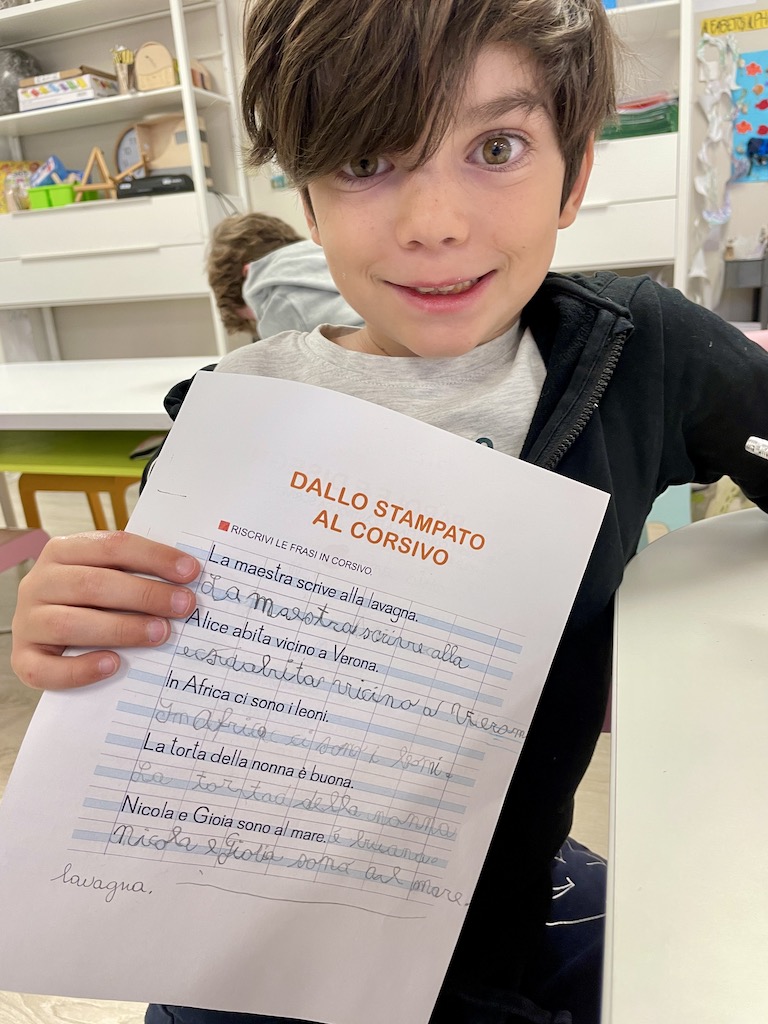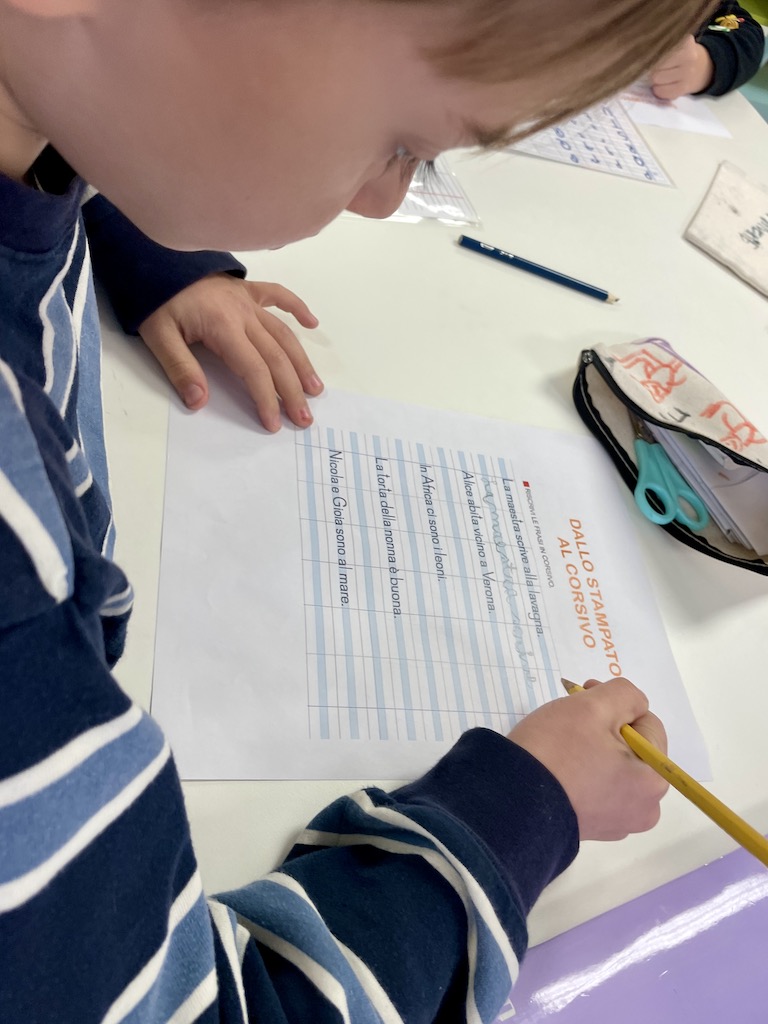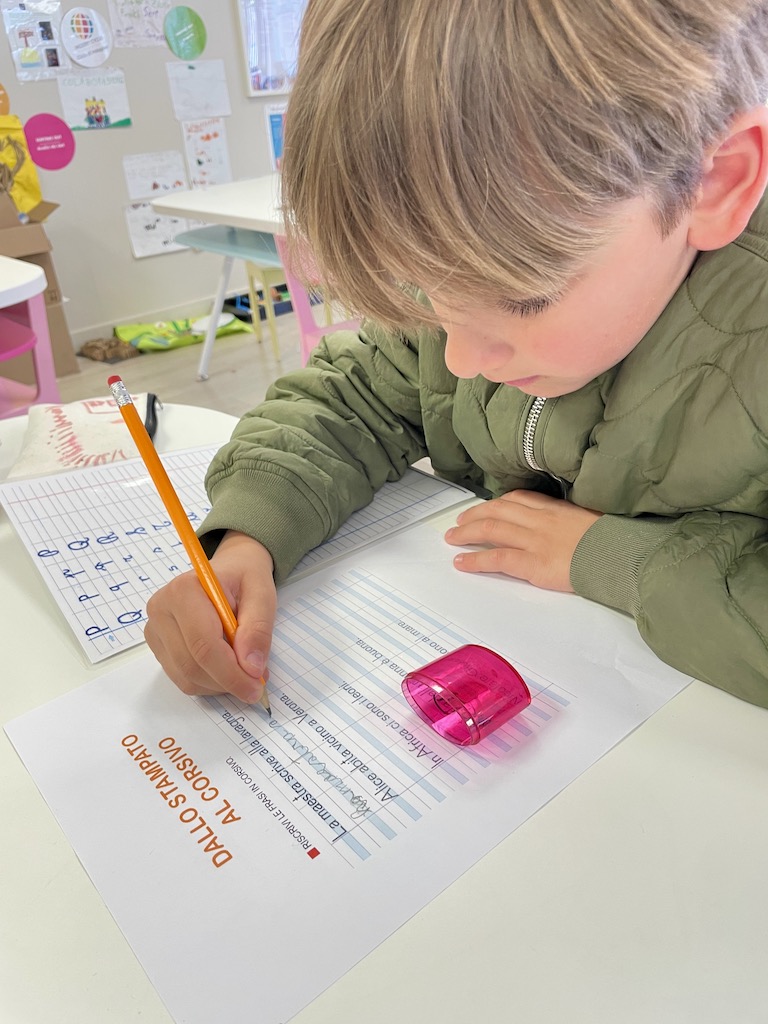At La Scuola International School, we believe in nurturing the whole child through thoughtful educational practices that honor both tradition and innovation. One of the ways we bring this philosophy to life is through our commitment to teaching cursive handwriting—an art form that beautifully complements our Reggio Emilia approach and International Baccalaureate framework.

Why Cursive Matters in a Digital Age
In a world where keyboards and touchscreens dominate, you might wonder why we dedicate time to teaching cursive handwriting. The answer lies in the remarkable benefits this practice offers our students:
- Neural Development: Research shows that the fluid movements of cursive writing activate areas of the brain that digital typing simply doesn’t reach, creating neural pathways that support cognitive development.
- Fine Motor Skills: The precision required in cursive writing develops fine motor control that benefits children across many areas of learning and life.
- Focus and Patience: In our fast-paced world, cursive writing encourages children to slow down, concentrate, and appreciate the process as much as the outcome.
- Self-Expression: Each child’s cursive handwriting becomes as unique as their fingerprint—a personal expression of their identity and growth.

Cursive Through the Reggio Lens
As a Reggio Emilia-inspired school, we view cursive writing as a perfect embodiment of our educational philosophy:
- The Environment as Teacher: Our classrooms feature beautiful examples of cursive writing, from poetry on the walls to handwritten notes in our documentation panels, creating an environment rich with this expressive language form.
- The Hundred Languages: In the Reggio approach, we recognize that children have “a hundred languages” to express themselves. Cursive handwriting becomes yet another powerful language through which children can communicate their thoughts, feelings, and discoveries.
- Collaborative Learning: Students often work together on cursive projects, sharing techniques and celebrating each other’s progress—embodying the social constructivist approach so central to Reggio education.
Cursive and the IB Framework
Our IB curriculum values inquiry, international-mindedness, and holistic learning—all of which connect meaningfully with our cursive writing program:
- Transdisciplinary Learning: Cursive writing weaves naturally through our units of inquiry. Students might explore historical documents in their original cursive form, write reflective journals about their learning, or create artistic pieces that combine cursive writing with visual elements.
- International Perspective: We explore how handwriting differs across cultures and languages, helping students appreciate diverse forms of communication and expression.
- Learner Profile Attributes: The practice of cursive writing develops many IB Learner Profile attributes—students become more reflective as they assess their progress, balanced as they combine traditional and modern skills, and risk-takers as they persist through challenges.

Our Journey Through the Grades
Our cursive writing journey begins in PreK with playful pre-writing activities and continues through 8th grade with increasingly sophisticated applications:
- PreK-K: Children explore the fluid motions of writing through large motor activities, sensory experiences, and pattern work that lays the foundation for cursive.
- Grades 1-2: Formal introduction to cursive letters begins, with emphasis on proper posture, pencil grip, and the basic connecting strokes.
- Grades 3-5: Students refine their skills and begin to use cursive for authentic purposes—writing letters, creating poetry, and keeping learning journals.
- Grades 6-8: Cursive becomes a tool for self-expression and academic work, with students developing their personal style while maintaining legibility and fluency.
What the Children Are Telling Us
While the cursive journey begins formally in Grade 1, it is preceded by months of attention to pre-graphismo skills—developing control, confidence with lowercase and uppercase print, and connecting sound to symbols within our Italian immersion environment. Cursive enters as a new form of expression, but also as a natural next step.
What made this transition especially meaningful was the way students reflected on it—in their own words. One student shared,
“The challenge for me was the cursive we started this week. It was hard because it was hard to write in cursive.”
– Grade 1 student, December
Each week across the K–5 classrooms, two students take a lead role in responding to three prompts in their class’s edition of La Settimana:
- A favorite part of the week
- A challenge or new experience, and how their thinking has changed
- A process, project, or strategy they’ve used
From mid-December through mid-March, these reflections revealed a compelling arc in how students experienced cursive. In the early weeks, it appeared consistently under “challenges.” Students described it as “difficult to make the letters attached” and “hard to write the sentence in cursive.”
These initial challenges—shared by both boys and girls—reflected the newness of the experience and the focus required to work at their learning edge. Writing in cursive in Italian added another layer of complexity. One student noted,
“A challenge for me was when we write in Italian in cursive because it is very difficult.”
By February, however, the tone began to shift. For the first time, students began naming cursive as their favorite part of the week:
“My favorite part of the week was cursive because I like to practice my handwriting.”
“I like to write.”
And by March:
“I enjoyed writing in cursive—it’s fun.”
(Shared by the same student who had described it as hard 10 weeks earlier.)
Even as cursive continued to appear occasionally under “challenges,” students also expressed how their thinking was changing—evidence of emerging metacognition. What began with tentative effort became a source of genuine pride.
These reflections offer more than a progress report on handwriting. They show how students are learning to embrace challenge, reflect on progress, and find joy in a new form of self-expression. In our setting—where students are developing literacy in two languages—cursive has become a thread that connects focus, resilience, and creativity.
When we make space to hear their reflections, we are reminded: cursive isn’t just a skill. It’s a journey—and our students are narrating it beautifully.
A Parent’s Role
Parents often ask how they can support cursive writing at home. Here are some suggestions:
- Model handwriting yourself—let your children see you writing notes, lists, or letters
- Create a writing-friendly space with quality materials
- Celebrate your child’s efforts rather than focusing on perfection
- Look for opportunities to use cursive in everyday life, from thank-you notes to family recipes
Join Us
We invite you to visit our classrooms to see cursive writing in action, integrated meaningfully into our Reggio Emilia and IB educational approach. You’ll witness not just the development of a skill, but the nurturing of curious, confident learners who can express themselves in multiple “languages”—including the flowing, connected language of cursive.At La Scuola, we don’t teach cursive simply because it’s traditional; we teach it because it’s transformative. In those flowing, connected letters, we see the perfect metaphor for what education should be: a process that connects skills to purpose, tradition to innovation, and children to their own unique potential.
Share this Post
